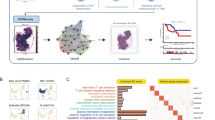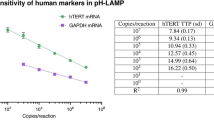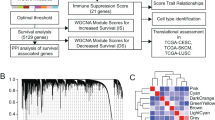Abstract
High risk HPVs (human papillomaviruses) are causally involved in the development of cervical cancer. However, other factors, such as somatic genetic alterations also play a decisive role in malignant conversion of cervical keratinocytes. Mutations and chromosomal aberrations are known to influence the pattern of gene expression. Therefore we used the recently developed RT–PCR based method of differential display of mRNAs to detect differences in gene expression which correlate with tumorigenicity. Non-tumorigenic HPV16-immortalized human foreskin keratinocytes (HPK IA) were compared with their tumorigenic counterparts and 49 different genes were identified which were either up- or downregulated. The identified genes encode proteins of the cytoskeleton and the extracellular matrix, the nuclear splicing apparatus, transcription regulators and membrane-associated proteins. The expression pattern of all genes was also examined by RNA–RNA in situ hybridization in biopsies of normal cervical epithelium, precancerous lesions and cancers. Two genes, C4.8 and C21.7, are of particular interest because their expression is upregulated in a subset of high grade precancerous lesions and in over 58% of cancers. These two genes may therefore be considered as putative progression markers. C4.8 is a new member of the transmembrane 4 (TM-4) protein family which includes tumor-associated antigens such as CD63 and TAPA-1, whereas C21.7 shows no significant homologies to any known genes or proteins.
Similar content being viewed by others
Article PDF
Author information
Authors and Affiliations
Rights and permissions
About this article
Cite this article
Nees, M., van Wijngaarden, E., Bakos, E. et al. Identification of novel molecular markers which correlate with HPV-induced tumor progression. Oncogene 16, 2447–2458 (1998). https://doi.org/10.1038/sj.onc.1201785
Received:
Revised:
Accepted:
Published:
Issue date:
DOI: https://doi.org/10.1038/sj.onc.1201785
Keywords
This article is cited by
-
Meta-analysis of downregulated E-cadherin as a diagnostic biomarker for cervical cancer
Archives of Gynecology and Obstetrics (2022)
-
The cancer-associated cell migration protein TSPAN1 is under control of androgens and its upregulation increases prostate cancer cell migration
Scientific Reports (2017)
-
Genome wide expression analysis in HPV16 Cervical Cancer: identification of altered metabolic pathways
Infectious Agents and Cancer (2007)
-
Ätiologie und Pathogenese des Zervixkarzinoms
Der Gynäkologe (2003)



